Dublin Winter Sweater |
|
 |
 |
Knitted sweater with round yoke in DROPS Air. The piece is worked top down with English rib and A-shape. Sizes XS - XXL.
DROPS 215-12 |
|
|
------------------------------------------------------- EXPLANATIONS FOR THE PATTERN: ------------------------------------------------------- RIB (in the round): ROUND 1: * Make 1 yarn over, slip 1 stitch as if to purl, purl 2 *, work from *-* to end of round. ROUND 2: * Knit together the yarn over and slipped stitch, purl 2 *, work from *-* to end of round. Repeat rounds 1 and 2. ENGLISH RIB (in the round): ROUND 1: * Knit together the yarn over and slipped stitch, make 1 yarn over, slip 1 stitch as if to purl, *, repeat from *-* to end of round. ROUND 2: * 1 yarn over, slip 1 stitch as if to purl, purl together the yarn over and slipped stitch *, repeat from *-* to end of round. Repeat rounds 1 and 2. INCREASE TIP (for increases in English rib stitch): All increases are worked on a round where the yarn overs and knitted stitches are knitted together (i.e. Round 1 in English rib). Increase 4 stitches in the English rib stitch as follows: Knit together the yarn over and knitted stitch, but do not slip them from the needle, make 1 yarn over the right needle, knit together the yarn over and knitted stitch again, move the marker to this stitch (= mid-stitch), make 1 yarn over the right needle, knit together the yarn over and knitted stitch again (= 3 stitches and 2 yarn overs), slip the stitches from the left needle. On the next round work the increased stitches as follows: * Make 1 yarn over, slip 1 stitch as if to purl, purl 1 *, work from *-* a total of 2 times, make 1 yarn over, slip 1 stitch as if to purl (= 3 knitted stitches and 2 purled stitches). The marker sits in the middle stitch of the increased stitches (in a knitted stitch). DECREASE TIP (mid under sleeve): All decreases are worked on a round where the yarn overs and knitted stitches are knitted together (i.e. Round 1 in English rib). Start mid under the sleeve (i.e. before the marker-stitch) and decrease 4 stitches on the round as follows: Work the first 2 stitches in English rib as before, slip the next stitch + its yarn over as if to knit, knit together the next 2 stitches + and their yarn overs and pass the slipped stitch + and its yarn-over over the knitted together stitches. Work until there are 4 stitches left before the marker stitch (= mid-stitch under the sleeve), knit together the next 3 stitches + and their yarn overs (= 2 stitches decreased), work the last stitch on the round. BINDING-OFF TIP: To avoid the bind-off edge being tight you can bind off with a larger size needle. If the edge is still tight, make 1 yarn over after approx. each 3rd stitch at the same time as binding off; the yarn overs are bind off as normal stitches. ------------------------------------------------------- START THE PIECE HERE: ------------------------------------------------------- SWEATER – SHORT OVERVIEW OF THE PIECE: The neck and yoke are worked in the round with circular needle, top down. On yoke, increase in 6 stitches marked with markers. The yoke is divided for body and sleeves and the body continued in the round with circular needle. The sleeves are worked in the round with short circular needle, top down. NECK: Cast on 78-78-84-90-90-96 stitches with circular needle size 4 mm = US 6 and Air. Knit 1 round. Then work RIB – read description above, for 12 cm = 4¾"; finish after round 2. The next round is worked as follows: * Make 1 yarn over, slip 1 stitch as if to purl, purl 2 together *, work from *-* to end of round = 52-52-56-60-60-64 stitches. Change to circular needle size 6 mm = US 10. Insert 1 marker thread at the beginning of the round; the yoke is measured from this marker thread. YOKE: Insert 6 markers in the piece as described below (without working the stitches). All markers are in knitted stitches and are used when increasing on the yoke. Count 8-8-8-10-10-10 stitches, insert marker 1 in the next stitch (= back right sleeve), count 5-5-7-5-5-7 stitches, insert marker 2 in the next stitch (= raglan-line in front), count 7-7-7-9-9-9 stitches, insert marker 3 in the next stitch (= mid-front), count 7-7-7-9-9-9 stitches, insert marker 4 in the next stitch (= raglan-line in front), count 5-5-7-5-5-7 stitches, insert marker 5 in the next stitch (= back left sleeve), count 11-11-11-13-13-13 stitches, insert marker 6 in the next stitch (= mid-back), there are 3 stitches left on the round. Work ENGLISH RIB in the round – read description above. REMEMBER THE KNITTING GAUGE! When you have worked 2-2-6-2-6-2 rounds of English rib, increase stitches on the next round as follows: Increase 4 stitches in all 6 marker-stitches - read INCREASE TIP (= 24 stitches increased on the round). Increase like this every 12th-10th-10th-10th-8th-10th round (every 6th-5th-5th-5th-4th-5th round of visible English rib stitches) a total of 5-6-6-7-8-8 times at markers 1, 2, 4 and 5 and a total of 4-5-6-6-7-8 times at markers 3 and 6 = 164-188-200-220-244-256 stitches on the needle. If the knitting gauge is correct in height, the piece measures approx. 20-20-22-24-24-28 cm = 8"-8"-8¾"-9½"-9½"-11" from the marker on the neck. Increases at markers 3 and 6 continue two more times on the piece (i.e. a total of 6-7-8-8-9-10 increases mid-front and mid-back); if the piece is shorter than 20-20-22-24-24-28 cm = 8"-8"-8¾"-9½"-9½"-11", some of these increases might be on the yoke. The number of stitches when dividing the yoke for body and sleeves will then not be the same as described below. The extra stitches will be on the front and back pieces. (Markers 1 and 5 also have further increases after the division, but these are described under SLEEVE.) Continue working until the piece measures 22-22-24-25-27-29 cm = 8¾"-8¾"-9½"-9¾"-10⅝"-11⅜" from the marker on the neck. On the next round divide for the body and sleeves as follows: Work the first 14-16-16-18-20-20 stitches as before, place the next 31-35-37-43-47-49 stitches on a thread for the sleeve, cast on 7 stitches under the sleeve, work the next 51-59-63-67-75-79 stitches as before, place the next 31-35-37-43-47-49 stitches on a thread for the sleeve, cast on 7 stitches under the sleeve and work the remaining 37-43-47-49-55-59 stitches as before. BODY: = 116-132-140-148-164-172 stitches – this stitch-count is only applicable if you have increased 4-5-6-6-7-8 times at markers 3 and 6 on the yoke. If you have increased more times on the yoke there will be more stitches on the needle now). Continue in the round with English rib as before and work the last 2 increases at markers 3 and 6 if necessary. The stitches under the sleeve are worked without knitting together stitches and yarn overs on the first round. When all the increases are finished there are 132-148-156-164-180-188 stitches on the body. Work until the piece measures 26-28-28-29-30-29 cm = 10¼"-11"-11"-11⅜"-11¾"-11⅜" from the division (adjust so the next round is one where stitches and yarn overs are knitted together). There is approx. 5 cm = 2" left to finished length; try the sweater on and work to desired length. Change to circular needle size 4 mm = US 6 and work rib as follows: * Knit the first stitch and yarn over together as before, 1 yarn over (= 1 stitch increased), purl 1 *, work from *-* to end of round = 198-222-234-246-270-282 stitches. Then work the same rib as on the neck for 5 cm = 2" (yarn overs worked twisted on the first round). Loosely bind off with knit over knit and purl over purl - read BINDING-OFF TIP! The sweater measures approx. 56-58-60-62-64-66 cm = 22"-22¾"-23⅝"-24⅜"-25¼"-26" from the shoulder down. SLEEVE: Place the 31-35-37-43-47-49 stitches from the thread on the one side of the piece on short circular needle size 6 mm = US 10 and knit up 1 stitch in each of the 7 stitches cast on under the sleeve = 38-42-44-50-54-56 stitches. Insert a marker thread in the middle of the 7 stitches under the sleeve (a knitted stitch in the English rib pattern). This stitch will be where you decrease under the sleeve later. Start the round before the mid-stitch and work as follows: Continue in the round with English rib as before; the knitted-up stitches under the sleeve are worked without knitting together stitches and yarn overs on the first round. At the same time increase at marker 1 (or 5 depending on which sleeve you are working) from the yoke and decrease stitches under the sleeve as described below: INCREASES: Continue to increase as before at marker 1/5 (= 4 stitches increased on each increase-round). Increase like this every 12th-10th-10th-10th-8th-10th round a total of 4 times. After the first increase there are 42-46-48-54-58-60 stitches (subsequently the number of stitches stays the same as you decrease at the same time as you increase). DECREASES: When working increase 2, decrease at the same time under the sleeve – read DECREASE TIP (= 4 stitches decreased on each decrease-round). Decrease like this on every round where you also increase (a total of 3 times). In other words, at increase 1, you are left with 42-46-48-54-58-60 stitches. Then the number of stitches remains the same on subsequent increase/decrease rounds. Continue with English rib until the sleeve measures 34-35-34-33-32-30 cm = 13⅜"-13¾"-13⅜"-13"-12½"-11¾" (there are 3 cm = 1⅛" left to finished length). Now work the next round in rib in the same way as on the body; i.e. the yarn overs and knitted stitches are knitted together, increase 1 stitch after each knitted stitch and purl the purled stitch = 63-69-72-81-87-90 stitches. Change to circular needle size 4 mm = US 6 and work rib as on the neck (1 English rib stitch, purl 2) for 3 cm = 1⅛". Loosely bind off with knit over knit and purl over purl - remember BINDING-OFF TIP. The sleeve measures approx. 37-38-37-36-35-33 cm = 14½"-15"-14½"-14¼"-13¾"-13" from the division. Work the other sleeve in the same way. |
|

|
|
|
Have you made this or any other of our designs? Tag your pictures in social media with #dropsdesign so we can see them! Do you need help with this pattern?You'll find tutorial videos, a Comments/Questions area and more by visiting the pattern on garnstudio.com. © 1982-2024 DROPS Design A/S. We reserve all rights. This document, including all its sub-sections, has copyrights. Read more about what you can do with our patterns at the bottom of each pattern on our site. |
|








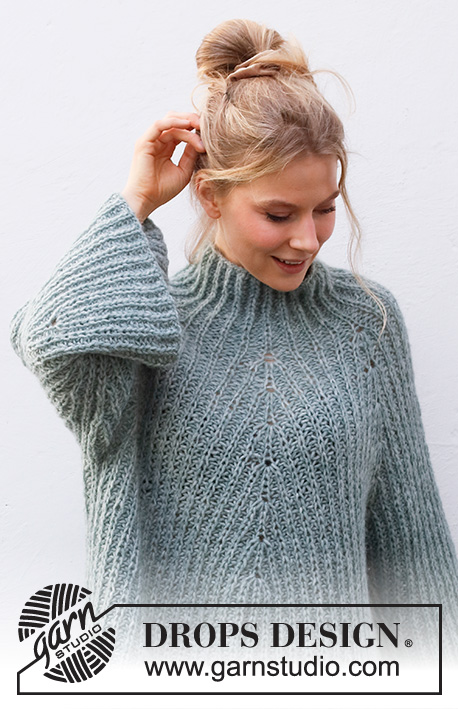


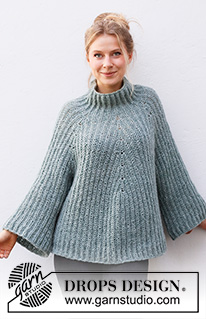

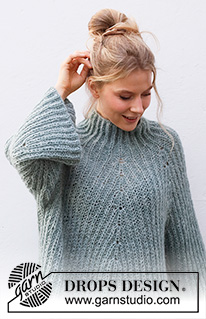





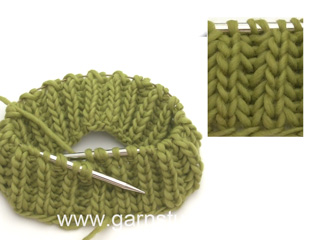


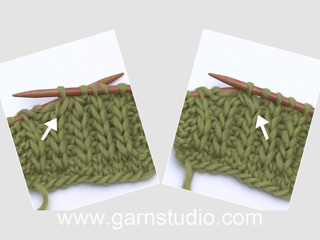
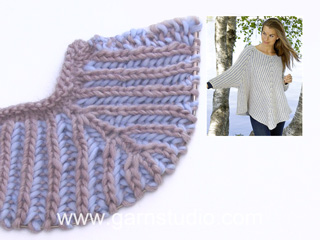
































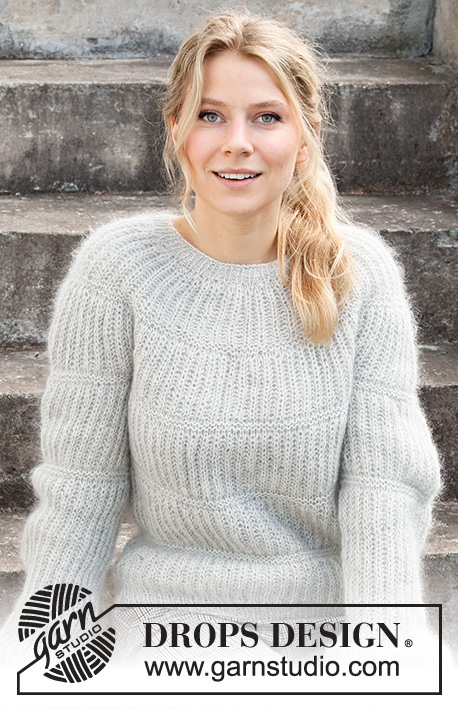
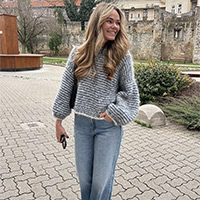


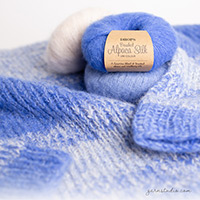


Comments / Questions (77)
Thanks for the reply drops.. just to clarify......in RIB and English rib, the Make 1 yarn over is never counted as a stitch ? Stitches on every alternate row keeps decreasing and increasing ?
17.10.2021 - 19:37DROPS Design answered:
Dear Shanthi, please see answer above.
17.10.2021 - 19:51Hi drops !! One more question. How do you get 52 stitches while working ‘ make 1yarn over, slip 1 stitch as if to purl, purl 2 tog ‘ on 78 stitches ? Can you explain ? Thank you in advance. 😊
17.10.2021 - 07:20DROPS Design answered:
Dear Shanthi, the yarn over doesn't count as a stitch, it's a part of the English rib, and is later on worked with their respective slipped stitch. Therefore, you decrease 1/3 of the initial stitches (when purl 2 tog), obtaining 52 stitches. Happy knitting!
17.10.2021 - 19:22Hi. Can you send me a video on how to increase 4 stitches in an English rib stitch ? Awaiting your reply. Thank you in advance !! Shanthi.
12.10.2021 - 16:30DROPS Design answered:
Dear Shanthi, all the relevant videos for this pattern are linked just below the pattern. Se the one with the title "How to increase in English rib by making several stitches in 1 stitch". Happy stitching!
13.10.2021 - 00:24Hoi, Dit begrijp ik volledig. Maar in uitleg staat ook dat de meerderingen op 3 en 6 gaan ook gewoon door. Totaal 8 keer. Vanaf welk punt gaan ze door? Ik moet toch elke 10de naald meerderen? De 7de keer van 3 en 6 vallen dan samen met de 7de keer op 1,2,4 en 5. Groeten Ella
02.10.2021 - 17:51Hoi. Vraag voor maat L. In totaal 7 keer op markeerdraden 1, 2, 4 en 5 en in totaal 6 keer op markeerdraden 3 en 6 = 220 steken op de naald. Maar markeerdraden 3 en 6 gaan nog twee keer door, dus totaal 8 keer. Als ik bij de 7 keer 24 steken toevoeg op markeerdraden 1, 2, 3, 4, 5 en 6 dan kom ik niet op 220 maar op 228 steken. Of moet ik hier 3 en 6 niet meerderen? Maar ik moet toch iedere 10e naald (iedere 5e naald van zichtbare Engelse patentsteek) meerderen.
30.09.2021 - 19:58DROPS Design answered:
Dag Ella,
Voordat je begint met meerderen heb je 60 steken op de naald. Voor maat L meerder je In totaal 6 keer op alle 6 markeerdraden, dus 6 x 24 = 144 en daarna nog 1 keer alleen op markeerdraden 1,2,4 en 5, dus 1 x 16 = 16, waarmee je op een totaal aantal steken komt van 220.
02.10.2021 - 12:44Buonasera. Ho provato a lavorare le coste iniziali come descritto ma non ho il risultato come in foto.e non ho trovato un video relativo. Ma non dovrei fare semplici coste 1/1? Grazie
14.09.2021 - 21:49DROPS Design answered:
Buonasera Samanta, le coste non sono semplici, ma lavorate seguendo quanto riportato nel paragrafo "COSTE" all'inizio delle spiegazioni. Buon lavoro!
14.09.2021 - 21:58Dopo i primi 12 cm. del collo, se faccio una gettata, una maglia passata e due maglie insieme non ottengo nessuna diminuzione. forse non devo fare la maglia gettata?
04.07.2021 - 23:17DROPS Design answered:
Buonasera Antonella, i gettati non si contano nel conteggio delle maglie. Buon lavoro!
05.07.2021 - 19:34No entiendo como para la talla M pasa en el cuello de tener 84 pts a 56 pts. Cuando se disminuye??
14.04.2021 - 22:43DROPS Design answered:
Hola Francisca. En la última vuelta del cuello cuando trabajan como sigue: Hacer 1 hebra, deslizar 1 punto como de revés, 2 puntos juntos de revés, se disminuyen 28 puntos.
25.04.2021 - 20:44Jeg strikker Dublin Winter Sweather, Drops 215/12. jeg har lagt opp 96 masker som det står, men når jeg skal begynne med merkene er det kun 64 masker som angis i mønsteret. På omgangen.
25.03.2021 - 21:12DROPS Design answered:
Hei Gerd, Etter du er ferdig med halsen skal du strikke en omgang hvor du feller 32 masker, før du bytter til pinne 6 (se oppskriften). God fornøyelse!
26.03.2021 - 07:551 HILO DE FLORA + 1 HILO DE KID SILK a que grosor de lana corresponde ?
22.03.2021 - 12:55